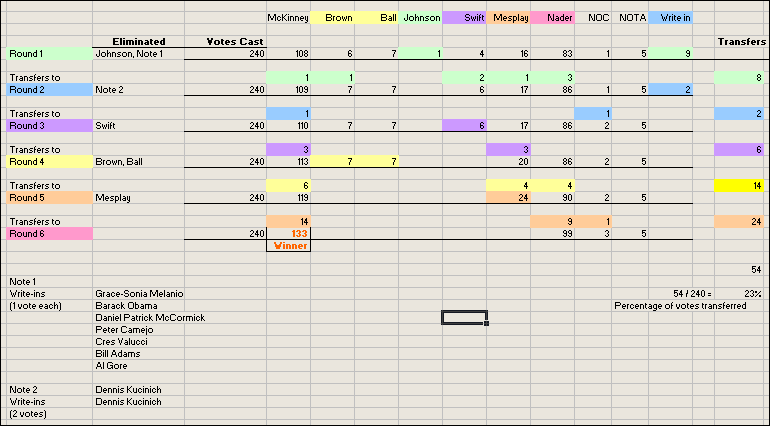
IRV Demonstration Vote | |
A demonstration of IRV using the 2008 Presidential Primary candidatesSponsored by the Electoral Reform Working Group | |
Introduction |
The GPCA promotes the use of a class of elections systems called "ranked ballot voting." Rather than being limited to casting your vote for just one choice on the ballot, ranked voting allows you to rank all candidates in order of preference. Then, if your first-choice candidate is eliminated, your vote transfers to your second choice. The specific method we are demonstrating here is commonly called "Instant Runoff Voting" (IRV), which is applicable to single-seat races (such as President, Governor or Mayor), as opposed to multi-seat races (such as a City Council or County Board of Supervisors). Through a series of candidate eliminations and vote transfers, the final winner in this mock primary election is chosen by receiving the highest rankings from the most voters. There are many advantages to ranked ballot voting:
|
Results |
The results came out pretty typical for this kind of race. In the Green Party Primary, two candidates (McKinney and Nader) received the predominance of the votes and ended up being the only real competitors. And McKinney had the lead in the first round and stayed ahead to the finish. But, IRV has confirmed that McKinney had broad support past the first round and was truly the voters' preferred choice in this mock election. If this race had been for a local office, the 1st round results would have triggered a runoff election, since no candidate had a majority. Using IRV would have prevented the need for a second election.
|
Details |
We have the details of how each voters' vote was transfered from round to round. You'll see the same color pattern used to identify the rounds. Most voters never had a transfer. But 42 of the voters were spared having their votes wasted by its transfer to their next choice. Some voters had five of six transfers, but their vote ultimately helped determine the outcome. |
 | |